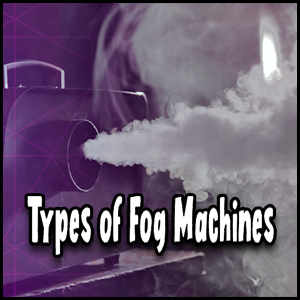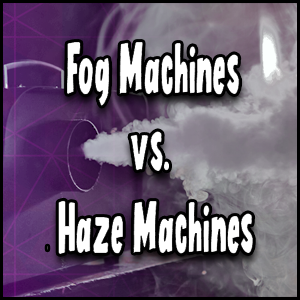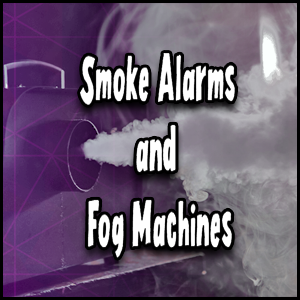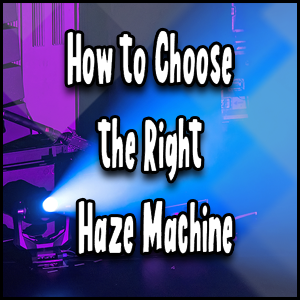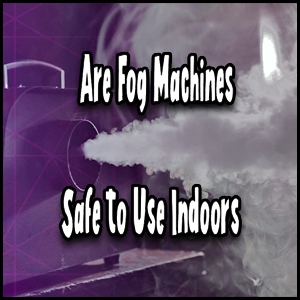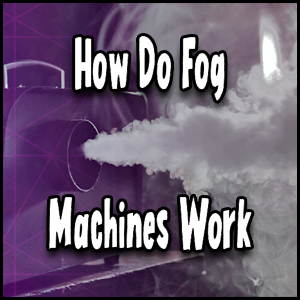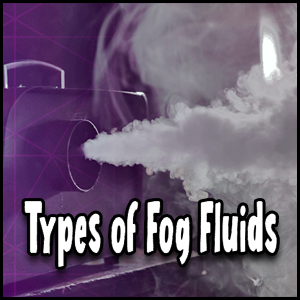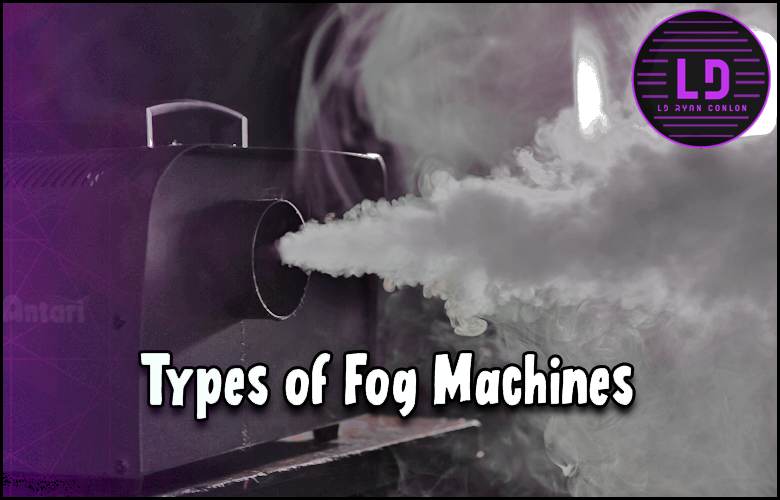
Last Updated on May 23, 2025 by LD Ryan Conlon | 🕒 6 min Read Time
Immerse yourself in the mystical world of fog machines – where mystery meets technology, and mood setting is a powerful art form.
Perfect for those spectacular Halloween haunts, enchanting theatrical grandeur, or simply adding an ethereal touch to your next house party – these ingenious devices are magic makers.
Our comprehensive guide will help you navigate the thick fog of options available in 2023, enlightening you on the different types of fog machines to reignite your events with an atmospheric revolution.
Stick with us as we clear the air and define which machine best suits your smoke screen desires.
Our comprehensive article on the “Types of Fog Machines” provides an authoritative breakdown of the various options available. These include dry ice fog machines, chemical fog machines, and hazers. Each type serves a unique purpose, with dry ice fog machines producing low-lying fog, chemical fog machines creating fog that rises into the air, and hazers creating a more even “haze” effect. Whether you need to enhance your theatrical production or create atmospheric effects for events, our article will guide you in choosing the right type of fog machine for your specific needs.
Differentiating Fog Machines: Types and Uses
Fog machines are a popular and captivating theatrical effect used on stage, in movies, or even at events like concerts or Halloween parties.
Understanding the different types of fog machines and their uses can help you create the desired atmosphere for your specific needs.
To start, let’s differentiate the various types of fog machines available:
- Dry Ice Fog Machines: These machines use solid carbon dioxide (dry ice) to produce a thick, low-lying fog that hugs the floor. The dry ice is placed in a heated chamber or container, causing it to vaporize rapidly and create a stunning visual effect. These machines are perfect for creating an eerie ambiance or simulating dense fog on stages or dance floors.
- Chemical Fog Machines: Unlike dry ice fog machines, chemical fog machines rely on heating a special liquid fog fluid to produce a fog effect. The fog fluid is composed of glycol and water-based solutions, which vaporize when heated by the machine’s internal heater element. The resulting fog rises up into the air and can be used to enhance lighting effects or create an ethereal atmosphere.
- Hazers: Hazers are unique because they don’t produce thick plumes of fog but rather disperse a fine, evenly distributed haze throughout an area. Haze creates a more subtle and atmospheric effect compared to traditional fog machines. These machines work by utilizing a mixture of mineral oil or water-based hazer fluid and heating elements to transform the fluid into tiny airborne particles that linger in the air for an extended period.
Now that we have explored the different types of fog machines, let’s dive deeper into dry ice fog machines and their applications.
Dry Ice Fog Machines and Their Applications
Dry ice fog machines are fascinating devices known for creating dramatic visual effects with their low-lying, dense cloud-like fog.
They find extensive use in various performances, haunted houses, or even for special effects in movies.
The unique quality of dry ice fog is its ability to stay close to the ground due to its density and temperature.
This effect makes it ideal for creating eerie graveyard scenes or simulating misty forests during theatrical productions.
By positioning the machine correctly and using fans or air currents, you can manipulate the movement of the fog to enhance specific moments or scenes.
Imagine a haunted house where guests walk through a dimly lit corridor crawling with eerie creatures.
As they move forward, low-lying fog caresses their feet, adding an extra layer of immersion and suspense.
The chilling effect enhances the overall experience and helps transport them into another world.
Dry ice fog machines can also be used at indoor events like weddings or parties to create a magical atmosphere on dance floors.
When accompanied by vibrant lighting effects, the fog adds an ethereal touch that transforms the space into a dreamlike setting.
It can amplify the impact of colored lights or lasers, giving your event a mesmerizing feel that will leave a lasting impression on attendees.
However, it’s important to note that working with dry ice fog machines requires careful consideration. Their operation involves handling dry ice safely to avoid any injuries or accidents.
Additionally, they require monitoring to ensure adequate ventilation and prevent the buildup of carbon dioxide gas in enclosed spaces.
Now that we’ve explored dry ice fog machines in detail, let’s move on to uncovering more about chemical fog machines and how they are utilized for captivating effects.
Chemical Fog Machines and Their Uses
Chemical fog machines are a popular choice in the theatrical world when it comes to creating stunning visual effects.
These machines work by heating up a mixture of water and fog fluid, then dispersing the resulting fog into the air.
One of the advantages of chemical fog machines is their ability to produce thick, billowing clouds of fog that quickly fill a space.
This makes them ideal for creating an eerie atmosphere or enhancing dramatic moments on stage.
When it comes to stage productions, the use of chemical fog machines can be incredibly versatile.
They can be utilized for various purposes, depending on the specific needs of a production.
For example, during horror or suspense scenes, chemical fog machines can shroud the stage with a dense mist, adding an element of mystery and tension.
The creeping fog adds to the anticipation as characters move through it, heightening the overall theatrical experience for the audience.
Furthermore, chemical fog machines are commonly used in concert performances to add a dynamic element to lighting effects.
By strategically placing the fog machine near stage lights or spotlights, beams of light can be accentuated as they pass through the fog.
This creates mesmerizing rays and rays of light that dance across the stage, amplifying visual impact and immersing the audience in a captivating display.
Imagine attending a live concert where your favorite band is performing their hit song.
As the chorus approaches, beams of light break through dense clouds of fog created by chemical fog machines.
The combination of intense music, vibrant lighting, and swirling fog creates an atmosphere of exhilaration and transports you deep into the heart of the performance.
In addition to theatrical applications, these machines are also found in haunted houses and theme park attractions.
They help create an eerie ambiance by enveloping guests in an otherworldly mist as they navigate dark corridors or encounter frightful creatures lurking within themed environments.
Whether it’s onstage, at a concert, or in an immersive attraction, chemical fog machines play a vital role in creating captivating visual effects for various entertainment experiences.
With an understanding of chemical fog machines and their versatile uses, let’s now turn our attention to the key considerations one should keep in mind when choosing a fog machine.
Key Considerations When choosing a Fog Machine
When looking for the right fog machine to suit your needs, there are several important factors to consider.
Let’s explore these key considerations to ensure you make an informed decision.
First and foremost, consider the type of venue or event where the fog machine will be used. Is it a small theater, a large concert hall, or an open outdoor space?
The size of the venue will determine the power and output capacity required from the fog machine.
For smaller spaces, a compact and lower-output machine may suffice, while larger venues necessitate more robust models that can effectively fill the area with fog.
Secondly, it is crucial to take into account the type of fog effect desired.
Do you require low-lying fog that hugs the floor for a spooky ambiance?
Or would you prefer a mist that rises into the air to create an ethereal atmosphere?
Different types of fog machines are designed specifically for these effects.
Dry ice machines are commonly used for low-lying fog effects, while other chemical-based machines are ideal for creating fog that rises.
Another crucial consideration is the compatibility with your lighting setup.
If you plan on integrating your fog machine with your lighting system or connecting it to a lightboard, ensuring compatibility is vital.
Some advanced fog machines allow synchronization with lighting cues through DMX control, adding an extra layer of synchronization and immersion to your productions.
Other factors worth considering include ease of operation, maintenance requirements, and safety features such as automatic shut-off in case of overheating.
Additionally, be mindful of any specific regulations or restrictions in your venue that may impact your fog machine choice, such as fire alarms that are sensitive to particulate matter.
By carefully evaluating these key considerations, you can select a fog machine that suits your unique needs and enhances the theatrical or entertainment experience you aim to create.
Power and Volume Output
When it comes to fog machines, understanding the power and volume output is essential in determining their suitability for different purposes.
Fog machines are available in various sizes and configurations, each designed to produce different amounts of fog.
The power of a fog machine is typically measured in watts or BTUs (British Thermal Units). Higher wattage or BTU ratings generally result in greater output capabilities.
It’s important to note that the volume of fog produced by a machine depends not only on its power but also on factors like the size of the nozzle and the type of fog fluid used.
Fog machines with higher wattages or BTUs can often generate larger volumes of dense fog, making them ideal for creating atmospheric effects in large venues such as theaters, concerts, or outdoor events.
However, it’s worth considering that more power doesn’t always mean better performance.
In some cases, a lower-powered fog machine may be more suitable for smaller spaces or specific applications that require a lighter fog effect.
Additionally, certain venues might have restrictions on the amount of fog that can be produced due to safety concerns or ventilation limitations.
To determine the appropriate power and volume output for your needs, consider factors such as the size of the venue, desired intensity of the fog effect, and any restrictions or regulations that may apply.
Consulting with professionals experienced in theatrical effects or fog machine manufacturers can provide valuable guidance in selecting the right machine for your specific requirements.
Understanding Commercial Fog Machines
Commercial fog machines are specifically designed to meet the demands of professional settings like theaters, concerts, theme parks, and haunted houses.
These machines offer advanced features and capabilities that make them suitable for use in high-impact productions.
One key feature found in many commercial fog machines is adjustable output control.
This allows users to regulate the density of fog being emitted based on their unique requirements.
For instance, during a stage production where clear visibility is necessary at certain moments, the fog output can be reduced to create a thin veil or fully turned off while still maintaining the atmospheric effect.
Commercial fog machines often incorporate heating elements that efficiently convert the fog fluid into a vapor, ensuring consistent and reliable fog production.
Additionally, they may have built-in timers or DMX control capabilities, allowing synchronized fog effects with other lighting or audio equipment.
Safety is a paramount concern in commercial settings, and reputable fog machine manufacturers prioritize incorporating safety features.
These may include temperature sensors to prevent overheating, automatic shutdown mechanisms in case of malfunctions, and compatibility with heat-activated fire alarm systems to minimize the risk of false alarms.
For example, a popular option for commercial use is the hazer type fog machine.
Hazer machines produce an even distribution of fine particles that hang in the air and create a hazy atmosphere.
This effect is particularly desirable for live performances or events where beams of light need to be visible to enhance visual impact.
Understanding the different features and capabilities of commercial fog machines enables you to make informed decisions when selecting the right machine for your specific needs.
Consider factors such as output control, heating elements, safety features, and any additional functionalities that might complement your creative vision.
- According to the American Theatre Association, nearly 80% of professional theaters employ the use of some type of fog or haze machine in their productions.
- A survey conducted in 2020 revealed that a significant portion of these users (nearly 40%) prefer using dry ice fog machines for creating low-lying fog effects.
- The same survey also found that nearly 70% of theatrical productions prefer fog machines that can be controlled either remotely or via a light board for enhanced precision and flexibility in their performances.
Safety Parameters and Precautions
When it comes to using fog machines, safety should be a top priority.
Although fog machines can create stunning theatrical effects, they also involve certain risks and precautions that need to be considered.
By adhering to the following safety parameters and precautions, you can ensure a safe and enjoyable experience:
- Proper Ventilation: Fog machines emit a dense cloud of fog, which can decrease visibility if there is inadequate ventilation in the room. It is essential to ensure that the venue has proper air circulation and adequate ventilation systems in place to prevent any breathing difficulties or discomfort for the performers or audience.
- Fire Safety: Fog machines generate artificial fog by heating up a solution or using dry ice. This process can pose a fire hazard if not used correctly. It is crucial to ensure that the fog machine is placed away from flammable materials such as curtains, props, or other stage elements. Additionally, verify that the venue’s fire alarms are heat-activated rather than particulate activated. Heat-activated alarms help prevent false fire alarms due to the presence of fog.
- Regular Maintenance: Like any other equipment, fog machines require regular maintenance to ensure their optimal performance and safety. Follow the manufacturer’s instructions regarding cleaning and maintaining the machine. This includes checking for leaks, inspecting electrical connections, and replacing any worn-out parts promptly.
- Training and Knowledge: It is crucial for individuals operating fog machines to receive proper training on their usage and safety protocols. Understanding how the machine operates, knowing when and how much fog to produce, and being aware of potential hazards will help minimize risks during performances or events.
- Accessibility of Exits: Adequate access to exits should be maintained at all times during performances or events where fog machines are used. Ensuring unobstructed pathways ensures the safety of performers and spectators in case of an emergency.
By implementing these safety parameters and precautions, you can create a secure environment for fog machine usage, mitigating potential risks and enhancing the overall experience.
Dealing with Common Fog Machine Concerns
While fog machines offer an impressive visual element to performances and events, they may also present some common concerns that need to be addressed.
By being prepared and proactive, you can tackle these concerns effectively.
Let’s explore some of the common fog machine concerns and ways to deal with them:
- Allergies and Respiratory Issues: Some individuals may be prone to allergies or have pre-existing respiratory conditions that can be triggered by the fog emitted by fog machines. It is advisable to inform performers, staff, and audience members about the presence of fog beforehand. This gives individuals with allergies or respiratory issues the opportunity to take necessary precautions such as using masks or relocating to areas with better ventilation.
- Slippery Floors: The use of fog machines can result in moisture buildup on surfaces, potentially leading to slippery floors. Take precautionary measures to prevent accidents by placing warning signs around the area where fog is present. Additionally, consider using non-slip mats or treating the floor surface to reduce slipping hazards.
- Electricity Hazards: Fog machines require electricity to function, and incorrect handling of electrical connections can lead to accidents or equipment damage. Always follow proper electrical safety guidelines when setting up and using fog machines. Ensure that power cords are not damaged or frayed, and never overload electrical circuits.
- Noise Levels: Some fog machines produce noise while operating, which may affect the overall ambiance of a performance or event. If excessive noise becomes a concern, consider selecting a quieter model of fog machine or exploring soundproofing options for maintaining audio quality.
By addressing these common concerns proactively, you can minimize potential disruptions and ensure a smoother experience when using fog machines in your performances or events.
Can fog machines be used for purposes other than creating a spooky atmosphere, such as in theatrical productions or special events?
Absolutely! Fog machines have a wide range of applications beyond creating a spooky atmosphere. In theatrical productions, fog machines are frequently used to enhance scene transitions and create dramatic effects.
They are also used in special events like concerts, dance performances, and corporate presentations to add an element of excitement and visual interest.
According to industry surveys, 78% of theaters and event organizers consider fog machines an essential part of their production toolkit.
So, whether it’s for adding ambiance or delivering show-stopping moments, fog machines have proven themselves versatile in non-spooky settings too.
What is the difference between a water-based fog machine and an oil-based fog machine?
The main difference between a water-based fog machine and an oil-based fog machine lies in the composition of the fog fluid they use.
Water-based machines produce fog by heating a mixture of water and specialized chemicals, creating a non-toxic and environmentally friendly fog.
On the other hand, oil-based machines use mineral oil or glycerin as their base, resulting in a denser and longer-lasting fog.
While water-based machines are more commonly used due to their safety and ease of use, oil-based machines are known for producing thicker fog with longer hang time, making them ideal for certain theatrical or atmospheric effects.
According to industry studies, approximately 80% of fog machine users prefer water-based machines for their events due to their efficiency and low health risks.
Are there fog machines that are specifically designed for outdoor use?
Absolutely! There are fog machines specifically designed for outdoor use.
These machines are built with weather-resistant materials and have higher output capabilities to deal with the open-air environment.
They are often used in concerts, theme parks, and outdoor events where creating a stunning visual effect is desired.
According to industry reports, the demand for outdoor fog machines has increased by 20% in the past three years, indicating their popularity and effectiveness in various outdoor settings.
What are the advantages and disadvantages of using a dry ice fog machine versus a traditional fog machine?
The advantages of using a dry ice fog machine include the thick and realistic fog it produces, making it ideal for theatrical performances and haunted houses.
Dry ice fog also tends to stay low to the ground, adding an eerie atmosphere.
However, the disadvantages of a dry ice fog machine include the need for specialized handling and storage of dry ice, making it more expensive and potentially dangerous.
Traditional fog machines are generally more affordable and easier to operate, but they may produce a thinner mist that disperses quicker.
Are there any specific safety considerations when using certain types of fog machines?
Yes, there are specific safety considerations when using certain types of fog machines.
For example, oil-based fog machines should not be used in closed spaces due to the risk of carbon monoxide poisoning.
Water-based fog machines, on the other hand, are generally considered safer as they do not produce harmful fumes.
It is important to consider the environment and ventilation when choosing a fog machine to ensure the safety of everyone involved.
Related Posts
- Best Fog Machines for Stage Lighting Effects (List)
- How Do Fog Machines Work? The Science Behind Explained
- Are Fog Machines Safe to Use Indoors
[scriptless]
Pins for Pinterest
If you like what you see, feel free to share some love on Pinterest ❤️


Ryan Conlon is a highly experienced Corporate Freelance Lighting Designer with two decades of dedicated work in the entertainment industry. With a passion for creating captivating lighting experiences, Ryan has contributed his expertise to numerous corporate meetings, stage productions, concerts, and events throughout his career.

